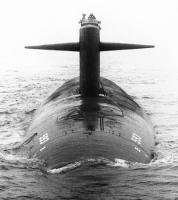 We recently posted an embedded video of Tom Paxton’s song, “The Thresher Disaster” sung my threelegsofman. about the loss of the nuclear submarine USS Thresher in 1963. Brian Frizell pointed out that Paxton’s song was not the only ballad about the Thresher. The Kingston Trio also sang a “Ballad of the Thresher.” The singer/songwriters Phil Ochs and Pete Seeger also had songs about the disaster, both titled simply “The Thresher.” Why did the sinking of this one ship inspire at least four songs?
We recently posted an embedded video of Tom Paxton’s song, “The Thresher Disaster” sung my threelegsofman. about the loss of the nuclear submarine USS Thresher in 1963. Brian Frizell pointed out that Paxton’s song was not the only ballad about the Thresher. The Kingston Trio also sang a “Ballad of the Thresher.” The singer/songwriters Phil Ochs and Pete Seeger also had songs about the disaster, both titled simply “The Thresher.” Why did the sinking of this one ship inspire at least four songs?
A moment of zen for a Saturday morning. Thanks to Steve Phelps for pointing it out on Facebook.
 Exactly what happened to the ill-fated Franklin expedition remains a mystery. in 1845, Captain Sir John Franklin, with a crew 129, attempted to traverse the last unnavigated section of the Northwest Passage and never returned. Some of the bodies expedition crew have been found but the wrecks of the two ships, Erebus and Terror have never been located despite a century and a half of searching. What is fascinating about the story is that parts of the mystery as to what happened to the expedition have appeared to have been solved several times, only to have new findings debunk the previous explanation. A new study suggests that the current theory of the failed expedition may also be flawed.
Exactly what happened to the ill-fated Franklin expedition remains a mystery. in 1845, Captain Sir John Franklin, with a crew 129, attempted to traverse the last unnavigated section of the Northwest Passage and never returned. Some of the bodies expedition crew have been found but the wrecks of the two ships, Erebus and Terror have never been located despite a century and a half of searching. What is fascinating about the story is that parts of the mystery as to what happened to the expedition have appeared to have been solved several times, only to have new findings debunk the previous explanation. A new study suggests that the current theory of the failed expedition may also be flawed.
 I would like to thank all those who came out last night to the Working Harbor Committee’s presentation of “Sailing Ships at Work – Past, Present and Future.” It was a fun evening and gratifying that the presentation was so well received. In my part of the presentation, I rashly suggested that there is at least the possibility that we could see a return of large cargo-carrying auxiliary sailing ships. Just as a hundred years of cheap energy killed off commercial sail, the economics of continued high fuel costs could support a return to modern sail, for certain types of ships, on specific trade routes.
I would like to thank all those who came out last night to the Working Harbor Committee’s presentation of “Sailing Ships at Work – Past, Present and Future.” It was a fun evening and gratifying that the presentation was so well received. In my part of the presentation, I rashly suggested that there is at least the possibility that we could see a return of large cargo-carrying auxiliary sailing ships. Just as a hundred years of cheap energy killed off commercial sail, the economics of continued high fuel costs could support a return to modern sail, for certain types of ships, on specific trade routes.
This brings to mind the recent account of the 47,000 DWT product tanker Nord Integrity. The ship’s captain, Rohit Minocha, took slow steaming one step farther by simply turning off the main engine and let the ship be carried on the winds and currents, covering 280 nm over 3-4 days. The ship arrived at the loading berth in Algeria on time and the enterprising captain saved Norden, the ship’s owner’s 27 tonnes of fuel oil worth over $17,000 in oil costs.
As reported in Norden’s News Magazine: “Head of NPP Operations, Jens Malund Jensen, gives Captain Rohit Minocha much praise for his initiative.
First it was the White House Easter Egg Hunt – cancelled due to the sequestration. Now it appears that Navy Fleet Weeks in ports around the country, traditionally held each spring, may fall victim to the automatic budget cuts as well. The New York Times is reporting that Fleet Week this year in New York harbor will be “significantly reduced if it occurs at all.” On Thursday, Rear Admiral John Kirby, a Navy spokesman, said that “no branch of the armed forces may participate in community relations or outreach events that come at additional cost to government or rely on anything other than local assets and personnel. We will follow that direction, to include participation in Fleet Weeks.”
There are also reports that no Navy ships will participate in Fleet Week in Portland, OR, from June 5 through June 9, though Coast Guard, Army and Canadian navy vessels may make an appearance. Likewise there will be no Navy ships at Seattle’s Fleet Week. The same appears to be the case in Fort Lauderdale and possibly San Francisco. Budget cuts have also grounded the Navy’s precision air squad, the Blue Angels.
Here is a short video of the New York Fleet Week from two years ago:
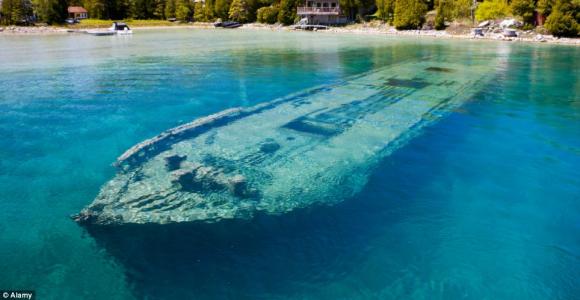
In Big Tub Harbour, just off Canada’s Georgian Bay, near the entrance to Lake Huron, lies the wreck of the schooner Sweepstakes, which sank in 1885. She is 119′ long with a 23′ beam and a 10′ depth of hold. Just twenty feet below the surface, she is considered by many to be the world’s most beautiful shipwreck. Whether or not that title can safely be bestowed on any particular wreck, she is a beauty, remarkably well preserved in the crystalline waters of the lake. Big Tub Harbor and the wreck of the Sweepstakes are now part of the Canada’s Fathom Five National Marine Park near the town of Tobermory, Ontario.
World’s most beautiful shipwreck: Haunting hull of Sweepstakes lies just TWENTY FEET below clear blue water of Ontario lake where it sank in 1885
Continue reading
On this the fiftieth anniversary of the sinking of the USS Thresher, we are reposting an article from three years regarding the link between the discovery of the wreck of the Titanic and the US Navy’s secret search for the lost submarines, USS Thresher and the USS Scorpion. Originally posted June 14, 2010.
Searching for the USS Thresher and USS Scorpion with the Titanic as Cover
Late last month, the secret was revealed – when Bob Ballard discovered the Titanic in 1985, he was actually on a secret mission to find two sunken US submarines, the USS Thresher and USS Scorpion, both of which had sunk in the Atlantic in the 1960s. Only after his team located and surveyed the two missing subs was he allowed to search for the Titanic, leaving only a twelve day window to located the sunken passenger liner.
NGC Presents : Titanic: Ballard’s Secret Mission
Fifty years ago today, the nuclear submarine USS Thresher (SSN-593) sank during deep diving tests in the Atlantic off Massachusetts with a loss of 129 officers, crewmen, and military and civilian technicians. The sinking of the submarine is considered to be a watershed event in the implementation of the rigorous US Navy submarine safety program SUBSAFE. The folk sinker Tom Paxton wrote a song about the tragedy, sung here on Youtube by threelegsoman.
Ships are the most energy efficient means of moving good across the surface of the earth. Goods moved by ship have the lowest carbon foot-print of goods moved by any other means. At the same time, modern ships are significant polluters. How can ships be so green and yet also so dirty. The answer is the fuel burned on most ocean-going ships. It goes by various names – residual oil, bunker C, No. 6 oil. Whatever you call it, it is dirty; high in sulfur, nitrogen dioxide and particulates. The exhaust gases from ocean going ships has become so bad that it can be observed from space by satellite. Thanks to Mai Armstrong of the Working Harbor Committee for pointing out the news.
The third of three wonderful videos shot by William Collinson sailing on the Bark Europa between the end of December 2012 and the early part of January 2013.
The second of three wonderful videos shot by William Collinson sailing on the Bark Europa between the end of December 2012 and the early part of January 2013.
Next Wednesday, April 10th, from 6-9 the Working Harbor Committee is presenting Sailing Ships at Work – Past, Present and Future. If you are in the New York area be sure to stop by. (Click on the banner to the right to learn more.) The future of working sail may come in all sizes, from large sailing bulk carriers to the sailing barges that only disappeared within the last fifty years in parts of the world. Here is a very interesting working sail project by Vermont farmer, Erik Andrus. He is building a sailing barge to carry non-perishable produce down Lake Champlain to the Hudson River and onward to the market in New York. They are attempting to raise $15,000 by April 25th on Kickstarter. The barge, to be named Ceres, is already under construction and will carry 24000 lbs of cargo and requires a working crew of two. She draws just 2 feet of water fully laden. Thanks to Bowsprite for passing the news along.
The Vermont Sail Freight Project
Vermont Farmer Building Sailboat To Transport Produce To NYC
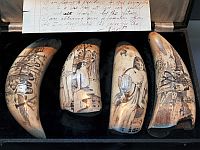 Last week we posted, “Vancouver Maritime Museum, Stephen Colbert & Whale Bone Porn,” about a controversy over an exhibit at the Vancouver Maritime Museum, Tattoos & Scrimshaw: the Art of the Sailor. One Vancouver mother and schoolteacher was offended by the erotic depictions on nine whale teeth which she described as “whale bone porn.” It appears that the exhibit may greater problems than merely erotic scrimshaw. James Delgado, director of maritime heritage for the United States’ National Oceanic and Atmospheric Administration, and a former executive director of the Vancouver Maritime Museum, says the teeth are not 19th-century scrimshaw.
Last week we posted, “Vancouver Maritime Museum, Stephen Colbert & Whale Bone Porn,” about a controversy over an exhibit at the Vancouver Maritime Museum, Tattoos & Scrimshaw: the Art of the Sailor. One Vancouver mother and schoolteacher was offended by the erotic depictions on nine whale teeth which she described as “whale bone porn.” It appears that the exhibit may greater problems than merely erotic scrimshaw. James Delgado, director of maritime heritage for the United States’ National Oceanic and Atmospheric Administration, and a former executive director of the Vancouver Maritime Museum, says the teeth are not 19th-century scrimshaw.
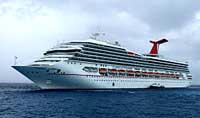 Winds gusting to near hurricane strength broke the moorings on the already damaged cruise ship Carnival Triumph at her berth at BAE Shipyard in the Port of Mobile, Alabama at 1:45 p.m. CT on Wednesday. The cruise ship, which had recently been adrift in the Gulf of Mexico for five days after a fire and an electrical failure, was adrift again, this time down the Mobile ship channel where it is reported to have collided with another ship. Two men were in a guard shack that was blown into the river. One man was recovered and the other is still missing.
Winds gusting to near hurricane strength broke the moorings on the already damaged cruise ship Carnival Triumph at her berth at BAE Shipyard in the Port of Mobile, Alabama at 1:45 p.m. CT on Wednesday. The cruise ship, which had recently been adrift in the Gulf of Mexico for five days after a fire and an electrical failure, was adrift again, this time down the Mobile ship channel where it is reported to have collided with another ship. Two men were in a guard shack that was blown into the river. One man was recovered and the other is still missing.
The AP reports that new damage to the cruise ship included “a 20-foot gash about 2 to 3 feet wide … visible about halfway up the hull from the water … wrapped partway around the stern. Underneath the gashed area, two levels of railing were dangling and broken.” The Carnival Triumph is reported to have drifted for several hours before tugs could secure the ship at the Mobile Cruise Terminal. Thanks to Brian Frissel for passing along the news.
The first of three wonderful videos shot by William Collinson sailing on the Bark Europa between the end of December 2012 and the early part of January 2013.
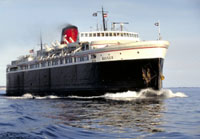 Toward the end of last year, we posted about the the battle over the continued operation of the SS Badger, the last coal-fired passenger vessel operating on the Great Lakes. To her admirers she is a national treasure. To her detractors she is a an environmental menace, dumping 4 tons of coal ash into Lake Michigan every day. The ferry’s EPA waiver which allowed her to dump the ash expired in December. Now an EPA Consent Decree has been issued allowing the ship to continue operating and dumping ash, although in lesser quantities, for the next two years.
Toward the end of last year, we posted about the the battle over the continued operation of the SS Badger, the last coal-fired passenger vessel operating on the Great Lakes. To her admirers she is a national treasure. To her detractors she is a an environmental menace, dumping 4 tons of coal ash into Lake Michigan every day. The ferry’s EPA waiver which allowed her to dump the ash expired in December. Now an EPA Consent Decree has been issued allowing the ship to continue operating and dumping ash, although in lesser quantities, for the next two years.
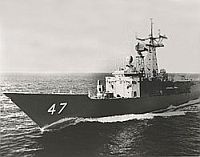 An April Fool’s post that is no joke. At 12:27 a.m. on April 1, 2010, in the Indian Ocean west of the Seychelles, three Somali pirates in a small skiff attacked what they thought was a merchant vessel. It wasn’t. They had attacked the USS Nicholas, an Oliver Hazard Perry-class frigate, on anti-piracy patrol. The USS Nicholas returned fire, captured the three pirates and sank their skiff. Subsequently, two suspected pirates were captured on a mother ship, which was also confiscated. The five pirates were tried and convicted in US court, the first piracy conviction in an American courtroom since 1819. The five April Fool’s pirates were each convicted to life plus 80 years. No joke.
An April Fool’s post that is no joke. At 12:27 a.m. on April 1, 2010, in the Indian Ocean west of the Seychelles, three Somali pirates in a small skiff attacked what they thought was a merchant vessel. It wasn’t. They had attacked the USS Nicholas, an Oliver Hazard Perry-class frigate, on anti-piracy patrol. The USS Nicholas returned fire, captured the three pirates and sank their skiff. Subsequently, two suspected pirates were captured on a mother ship, which was also confiscated. The five pirates were tried and convicted in US court, the first piracy conviction in an American courtroom since 1819. The five April Fool’s pirates were each convicted to life plus 80 years. No joke.
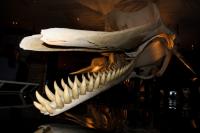 A new exhibit has just opened at the American Museum of Natural History in New York. While perhaps not as controversial as the exhibit at the Vancouver Maritime Museum which we posted recently, it includes many whales bones, but, at least to our knowledge, no whale bone porn. The new exhibit, Whales: Giants of the Deep, includes more than 20 skulls and skeletons from a range of whale species, including a skeleton of a male sperm whale that measures 58 feet long. Visitors are also invited to climb through the replica of a blue whale’s heart. The exhibit, which runs through Jan. 5, 2014, is on loan from the Museum of New Zealand Te Papa Tongarewa.
A new exhibit has just opened at the American Museum of Natural History in New York. While perhaps not as controversial as the exhibit at the Vancouver Maritime Museum which we posted recently, it includes many whales bones, but, at least to our knowledge, no whale bone porn. The new exhibit, Whales: Giants of the Deep, includes more than 20 skulls and skeletons from a range of whale species, including a skeleton of a male sperm whale that measures 58 feet long. Visitors are also invited to climb through the replica of a blue whale’s heart. The exhibit, which runs through Jan. 5, 2014, is on loan from the Museum of New Zealand Te Papa Tongarewa.
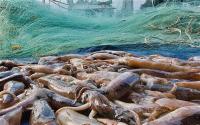
Photo: Alamy
The ongoing dispute over the Falkland/Malvinas Islands and adjoining waters, has created an opportunity for an outlaw fleet of industrial fishing trawlers to fish, and over-fish, the rich stocks of squid in Argentine waters near the islands. Illegal fishing is estimated to be catching 300,000 tons of squid a year. The squid is key to a food chain that sustains penguins, seals, birds and whales. In 2005 Argentina pulled out of a fisheries management organization it had shared with Falklands. The lack of cooperation between the UK and Argentina has left both sides ill-equipped to deal with the fleet scooping up squid.
 The Scottish government ignored the bluff, bluster and threats made by the bilious, billionaire blowhard, Donald Trump, and approved the installation of eleven wind turbines in an experimental offshore wind farm off the coast of Aberdeen. Trump is strongly of the view that the wind turbines will spoil the view from a golf course that he is developing nearby. The real-estate magnate and reality TV show opined, in a bizarre, yet not untypical tirade, ““All over the world they are being abandoned, but in Scotland they are being built. We will put our future plans in Aberdeen on hold, as will many others, until this ridiculous proposal is defeated. Likewise, we will be bringing a lawsuit within the allocated period of time to stop what will definitely be the destruction of Aberdeen and Scotland itself.”
The Scottish government ignored the bluff, bluster and threats made by the bilious, billionaire blowhard, Donald Trump, and approved the installation of eleven wind turbines in an experimental offshore wind farm off the coast of Aberdeen. Trump is strongly of the view that the wind turbines will spoil the view from a golf course that he is developing nearby. The real-estate magnate and reality TV show opined, in a bizarre, yet not untypical tirade, ““All over the world they are being abandoned, but in Scotland they are being built. We will put our future plans in Aberdeen on hold, as will many others, until this ridiculous proposal is defeated. Likewise, we will be bringing a lawsuit within the allocated period of time to stop what will definitely be the destruction of Aberdeen and Scotland itself.”
Scottish government ignores Donald Trump’s threats and approves windfarm

